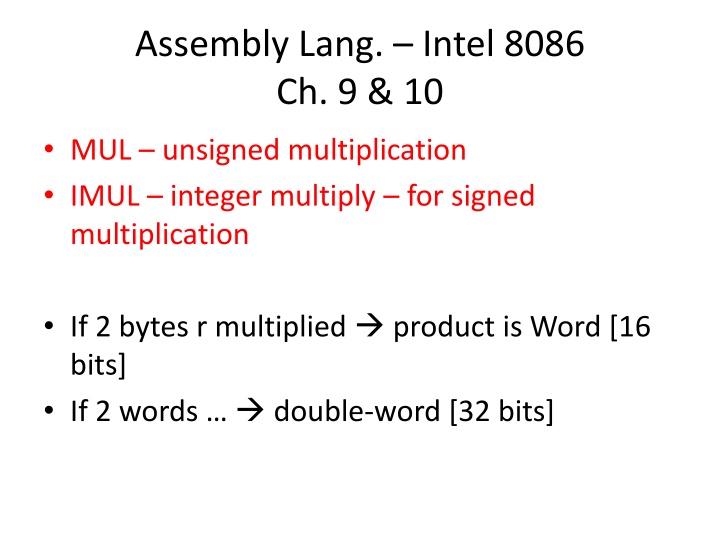
Intel 8086 Assembly Language Multiplication and Division Guide
Explore the concepts of unsigned and signed multiplication, along with integer division in Intel 8086 Assembly Language. Learn about multiplication with bytes, words, and how to compute factorials. Dive into division operations, including both unsigned and integer division with detailed examples and visuals.
Download Presentation

Please find below an Image/Link to download the presentation.
The content on the website is provided AS IS for your information and personal use only. It may not be sold, licensed, or shared on other websites without obtaining consent from the author. If you encounter any issues during the download, it is possible that the publisher has removed the file from their server.
You are allowed to download the files provided on this website for personal or commercial use, subject to the condition that they are used lawfully. All files are the property of their respective owners.
The content on the website is provided AS IS for your information and personal use only. It may not be sold, licensed, or shared on other websites without obtaining consent from the author.
E N D
Presentation Transcript
Assembly Lang. Intel 8086 Ch. 9 & 10 MUL unsigned multiplication IMUL integer multiply for signed multiplication If 2 bytes r multiplied product is Word [16 bits] If 2 words double-word [32 bits]
Byte form MUL source ;source= register, mem; not const. One no. is in source Another no. is in AL Product is in AX
Word form Source ; 16-bit reg/mem not const. AX MSB in DX, LSB in AX [DX:AX]
Q. A = 5xA 12xB A, B = word variables. No overflow. MOV IMUL MOV MOV IMUL SUB AX, 5 A A,AX AX,12 B A,AX ;AX=5xA ;A=5A ;AX=12 ;AX=12B ;A=5A 12B
DIV, IDIV DIV divide unsigned division IDIV integer divide DIV divisor 15 3 = 5, 3 is the divisor Byte form: Divisor 8-bt reg/mem Dividend 16-bit in AX After division, Quotient 8-bit in AL , Remainder 8-bit in AH
Word form: Divisor 16-bit reg/mem Dividend 32-bit in DX:AX After division, Quotient 16-bit in AX , Remainder 16-bit in DX
Ch. 10 1-D array DUP to define arrays whose elements share a common initial value E.g., GAMMA DW 100 Sets up an array of 100 words, with each entry initialized to 0. GAMMA DW 100 Sets up an array of 100 words, with each entry UN-initialized. DUP (0) DUP (?)
